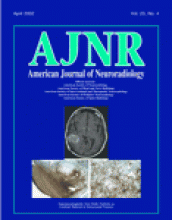Abstract
BACKGROUND AND PURPOSE: Although neuroangiography remains the criterion standard standard for the detection of and surgical/interventional planning for cerebrovascular diseases, it usually requires that patients be confined to bed rest for several hours after angiography to prevent local complications. Decreasing catheter size has reduced the risk of hemorrhagic complications associated with early ambulation after angiography. For this study, we prospectively evaluated the clinical feasibility of a 3.3F catheter/sheath system for selective neuroangiography.
METHODS: One hundred seventeen consecutive patients (49 men, 68 women; age range, 18–83 years; mean age, 56.9 years) underwent selective neuroangiography using 3.3F catheters. The exclusion criteria for this study included a subsequent surgical/neurointerventional procedure performed within 18 hours and necessity of arch aortography, which is routinely performed for the first examination of patients with ischemic cerebrovascular diseases. The procedure was evaluated prospectively in terms of success rate, compression time of the arterial puncture site, and periprocedural complications.
RESULTS: Selective catheterization of the intended arteries was performed in 99% of the carotid arteries and 97.4% of the vertebral arteries. No neurologic complications or local hemorrhagic complications were observed. Manual compression time after the procedure ranged from 3 to 7 minutes (mean, 3.7 minutes), and patient bed rest after the procedure ranged from 2 to 3 hours (mean, 2.04 hours).
CONCLUSION: Selective neuroangiography with a 3.3F catheter/sheath system is feasible and enables early ambulation in selected patients.
- Copyright © American Society of Neuroradiology












